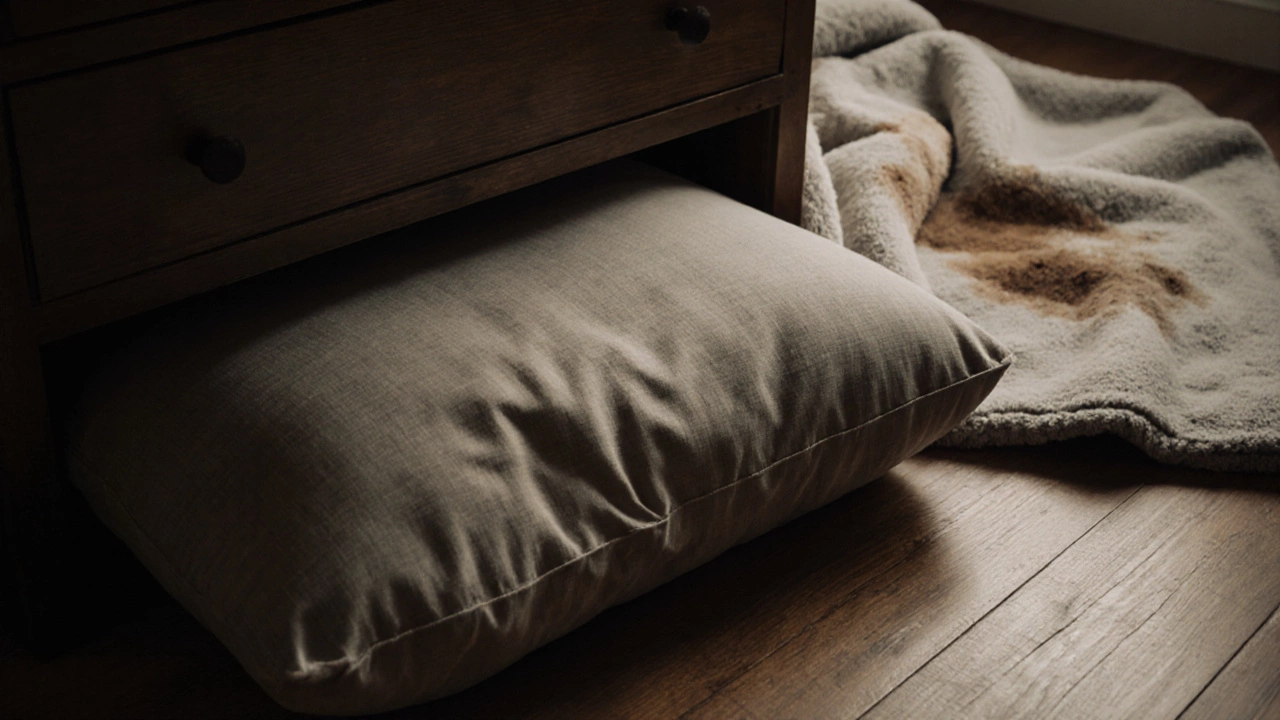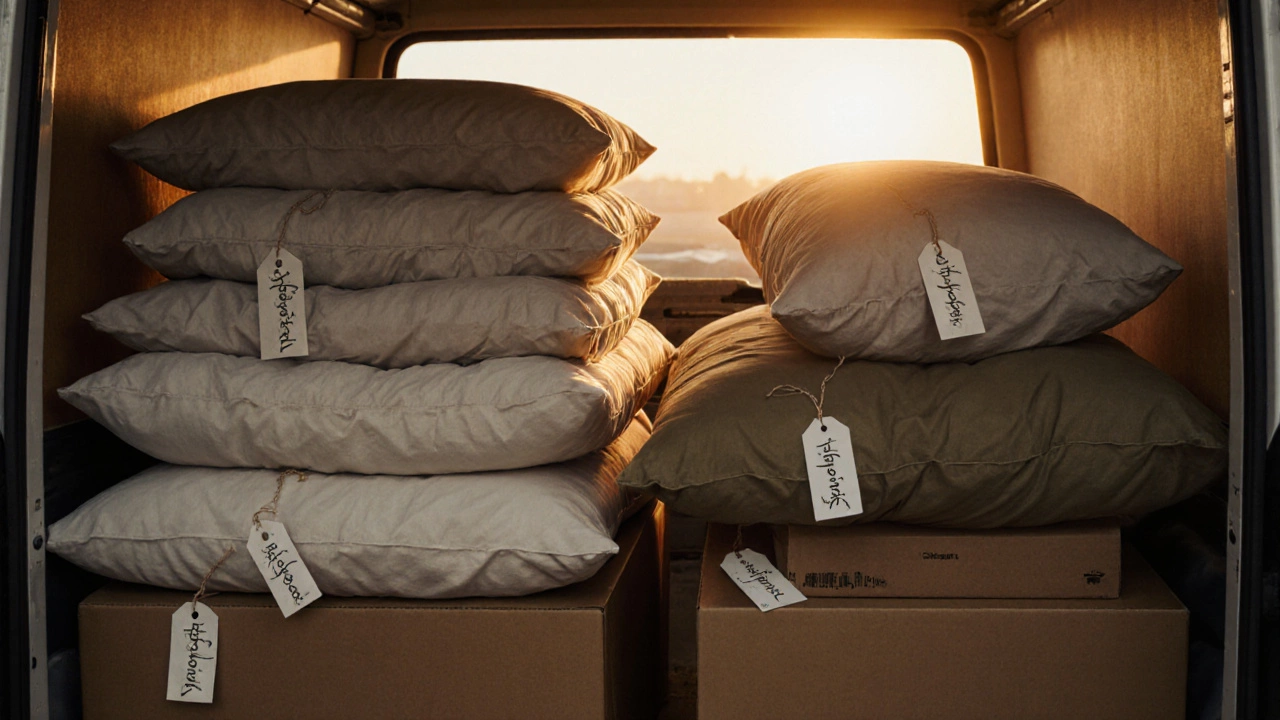Couch Cushion Removal Calculator
How to Use This Tool
Answer the questions below to get personalized recommendations for your couch cushions during your move.
Your Recommendations
When you’re packing up for a move, the couch is usually the biggest, heaviest item in the room. And those plush cushions? They’re the reason your sofa feels like a cloud-but also the reason it’s a nightmare to move. Should you take them off? Or leave them on and risk a tear, a stain, or a misshapen mess after the truck rolls away?
Why Removing Couch Cushions Matters
Leaving cushions on your couch during a move isn’t just inconvenient-it’s risky. Most sofas are built with removable cushions for a reason: they’re meant to be taken off for cleaning, reupholstering, or yes, moving. When you leave them on, you’re adding unnecessary bulk and weight. A typical three-seater sofa with cushions can weigh over 150 pounds. Take off the cushions, and you’re down to 90 or 100. That’s a huge difference when you’re carrying it up three flights of stairs or squeezing it through a narrow doorway.
Plus, cushions shift during transport. They slide, bunch up, or get crushed under other furniture. That’s how you end up with lopsided pillows that never sit right again. Memory foam and down fillings are especially sensitive to pressure. One crushed cushion can ruin the whole look-and comfort-of your sofa.
What Happens If You Don’t Remove Them
People who skip removing cushions often regret it. I’ve seen too many moves go wrong: a down-filled cushion gets squished flat after being stacked under a dresser. A cushion cover gets ripped on a sharp corner of a moving dolly. Or worse-someone spills coffee on the couch during the move, and the cushion stays on, soaking up the stain.
A 2023 survey by the American Moving & Storage Association found that 42% of people who moved with cushions still attached reported damage to their upholstery within six months. The most common issues? Permanent creases, uneven filling distribution, and fabric tears from friction against other furniture.
It’s not just about looks. A misshapen cushion can throw off the whole ergonomics of your sofa. If the back cushion slumps to one side, you’re sitting at an angle. If the seat cushion compresses unevenly, you’re not getting the support you paid for.
How to Remove and Pack Cushions the Right Way
Removing cushions isn’t hard-but doing it right matters. Here’s how to do it step by step:
- Take them off one at a time. Most cushions are either slip-on or secured with ties or zippers. Gently pull them free. Don’t yank. If there are ties, untie them slowly.
- Check for stains or damage. Use this chance to inspect each cushion. Spot clean any marks with a mild detergent and damp cloth. Let them dry completely before packing.
- Wrap each cushion individually. Use clean moving blankets or old sheets. Don’t use plastic wrap-it traps moisture and can mildew the filling. A cotton sheet lets air breathe.
- Secure the wrap. Use packing tape or twine to hold the wrapping in place. Avoid taping directly to the fabric-tape residue can stain.
- Label them. Write “Living Room - Left Back Cushion” on each one. This saves hours of guesswork when you’re unpacking.
- Pack them on top. Put cushions in the moving truck last, so they’re on top of heavier items. Never stack boxes or furniture on top of them.
If your cushions have zippers, you can remove the covers and wash them separately. Most are machine-washable in cold water on a gentle cycle. Always air dry-heat can shrink or warp the fabric.

When You Might Leave Cushions On
There are rare cases where leaving cushions on makes sense. If your sofa has built-in cushions that aren’t removable-like some modern, low-profile designs-you can’t take them off. In that case, you’ll need to protect them differently.
Use a fitted moving cover designed for sofas. These stretch over the whole piece and have reinforced corners. Wrap the entire sofa in a thick moving blanket, then secure it with straps. Make sure the cover doesn’t have zippers or seams that could rub against the cushion fabric during transit.
Also, if you’re moving locally and the sofa will be in the same truck for less than an hour, some movers skip removing cushions. But even then, it’s still safer to take them off. You’re not just protecting the couch-you’re protecting your time and sanity when you unpack.
What to Do After the Move
Don’t just toss the cushions back on the frame and call it a day. After you’ve set up your sofa in the new space:
- Let the cushions air out for a few hours. Moving blankets and plastic can trap odors.
- Fluff each one thoroughly. Slap the sides, knead the corners, shake out the filling.
- Rotate them. If one cushion was on the bottom during transit, move it to the top. Swap front and back cushions too.
- Wait 24 hours before sitting heavily on them. Foam and down need time to rebound.
Some people swear by putting the cushions in the dryer on low heat for 15 minutes with a clean tennis ball. It helps fluff up the filling. But only do this if the care label says it’s safe.

Pro Tip: Keep a Moving Checklist
Most people forget to plan for cushions until they’re halfway through the move. Make a quick checklist before you start packing:
- Number of cushions per sofa
- Are they removable? (Yes/No)
- Do they have zippers? (Yes/No)
- Are they washable? (Yes/No)
- Will you wash them before packing?
- Do you have enough moving blankets?
Keep this list taped to the side of the sofa. That way, even if you’re tired or stressed, you won’t forget.
Bottom Line
Yes, you should remove couch cushions when moving. It’s the single best thing you can do to protect your furniture, save your back, and avoid a post-move disaster. It takes 15 extra minutes, but it saves you from a $300 repair bill or a couch that never feels right again.
Think of it this way: your couch is one of the most used pieces of furniture in your home. It’s worth a little extra care. Don’t treat it like a box you can just shove into the truck. Treat it like something you’ll be sitting on for the next five years. Because you will.
Is it safe to leave couch cushions on during a long-distance move?
No, it’s not safe. Long-distance moves involve more handling, stacking, and vibration. Cushions left on the sofa are far more likely to shift, compress, or get damaged. Always remove them and pack them separately in moving blankets.
Can I use garbage bags to pack couch cushions?
No. Plastic garbage bags trap moisture and can cause mildew in fabric and foam. Always use breathable materials like cotton sheets or moving blankets. If you need to keep them dry, use a waterproof moving cover-not a plastic bag.
What if my couch cushions are glued in?
Some modern sofas have permanently attached cushions. If you can’t remove them, wrap the entire sofa in a fitted moving cover and use thick moving blankets underneath and on top. Secure everything with straps to prevent shifting. Avoid stacking heavy items on the sofa during transit.
Should I wash cushion covers before packing?
Yes, if they’re removable and washable. Cleaning them before packing removes dirt and oils that can set into the fabric during storage or transport. Always air dry completely before wrapping and packing.
How do I know if a cushion is damaged after the move?
Check for flat spots, lumps, or uneven surfaces. If a cushion doesn’t bounce back when pressed, or if the fabric is stretched or torn, it’s damaged. Down cushions may need fluffing; foam cushions that stay compressed may need replacement.






